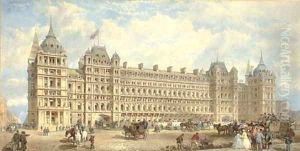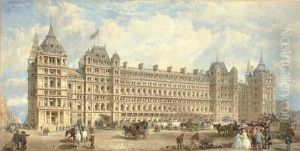Edward Middleton Barry Paintings
Edward Middleton Barry was a prominent British architect of the Victorian era, known for his significant contributions to the Gothic Revival architecture movement in England. Born on June 7, 1830, in London, he was part of the renowned Barry family of architects. His father, Sir Charles Barry, was the architect of the Houses of Parliament, a landmark of Gothic Revival architecture, which undoubtedly influenced Edward's future career and architectural style.
Edward's early life was steeped in architectural heritage, and he quickly followed in his father's footsteps, joining his practice and contributing to various projects. After his father's death in 1860, Edward took over the family firm and embarked on a series of notable projects that would leave a lasting mark on London's architectural landscape. Among his most famous works is the completion of the Houses of Parliament, particularly the design of the Victoria Tower, which remains a symbol of London to this day.
Beyond his work on the Houses of Parliament, Barry made significant contributions to the design and construction of numerous public buildings, theatres, and churches. One of his most celebrated projects was the Royal Opera House in Covent Garden, London, which he rebuilt in 1857-1858. His design for the theatre's auditorium and façade was applauded for its elegance and functionality, making it one of the premier opera houses in the world.
Barry's architectural style was characterized by a blend of Gothic and Renaissance elements, a hallmark of the Victorian Gothic Revival movement. He had a keen eye for detail and a profound understanding of historical architectural styles, which he adeptly incorporated into his designs. His work was not limited to public buildings; he also designed several private residences and was involved in urban planning projects, contributing to the development of Victorian London's character.
Edward Middleton Barry's contributions to architecture were widely recognized during his lifetime. He was elected a Royal Academician in 1869 and received numerous accolades for his work. Despite his relatively short life, Barry's legacy endures through his buildings, which continue to be admired for their architectural beauty and historical significance. He died on January 27, 1880, in London, but his vision and designs live on, cementing his place as one of the leading architects of the Victorian era.

